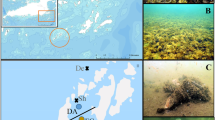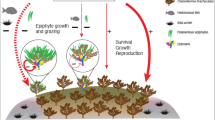Abstract
The influence of fucalean canopy species and dominant understory macroalgae on algal colonization was investigated to evaluate whether layering contributes to patterns in algal diversity. Patterns in recruitment were compared among total-clearing, understory-removal, canopy-removal, and undisturbed plots (plot area = 0.25 m2), using a randomized block design in depths <10 m and 10–20 m at Woody Island, Western Australia. To evaluate if propagules were available in the water column above the canopy layer, settlement plates (plate area = 0.04 m2) were deployed in depths <10 m, 10–20 m, and >20 m. A total of 198 macroalgal species was recorded. Biomass of the understory species Osmundaria prolifera Lamouroux and Botryocladia sonderi Silva was similar between canopy-removal and undisturbed plots. Diversity of macroalgae was similar in the presence and absence of a canopy layer. Taxa found in the canopy showed different patterns in recruitment. Cystoseiraceae recruited predominantly in total-clearings in both depth strata. Sargassaceae recruited most abundantly in depths <10 m. Density of canopy taxa on settlement plates was similar with depth (20–30 juveniles per plate), and juveniles were mainly Cystoseiraceae. In contrast to kelp beds or forests, patterns in algal colonization appeared to be maintained by environmental factors or processes other than the direct effects of layering in the subtidal fucoid-dominated assemblages at Woody Island.



Similar content being viewed by others
References
Anderson, M. J., 2001. A new non-parametric multivariate analysis of variance. Australian Ecology 26: 32–46.
Anderson, M. J., 2004. PERMANOVA: A FORTRAN Computer Program for Non-parametric Multivariate Analysis of Variance (for any two-factor ANOVA Design) using Permutation Tests. Department of Statistics, University of Auckland, Auckland.
Bray, J. R. & J. T. Curtis, 1957. An ordination of the upland forest communities of southern Wisconsin. Ecological Monographs 7: 325–349.
Britton-Simmons, K. H., 2004. Direct and indirect effects of the introduced alga Sargassum muticum on benthic, subtidal communities of Washington State, USA. Marine Ecology Progress Series 277: 61–78.
Clark, R. P., M. S. Edwards & M. S. Foster, 2004. Effects of shade from multiple kelp canopies on an understory algal assemblage. Marine Ecology Progress Series 267: 107–119.
Clarke, K. R. & R. N. Gorley, 2001. Primer v5: User Manual/Tutorial. PRIMER-E, Plymouth.
Critchley, A. T., P. R. M. De Visscher & P. H. Nienhuis, 1990. Canopy characteristics of the brown alga Sargassum muticum (Fucales, Phaeophyta) in Lake Grevelingen, southwest Netherlands. Hydrobiologia 204/205: 211–217.
de Eston, V. R. & W. O. Bussab, 1990. An experimental analysis of ecological dominance in a rocky subtidal macroalgal community. Journal of Experimental Marine Biology and Ecology 136: 170–195.
Deysher, L. & T. A. Norton, 1982. Dispersal and colonization of Sargassum muticum (Yendo) Fensholt. Journal of Experimental Marine Biology and Ecology 56: 179–195.
Emmerson, L. M. & A. C. Cheshire, 1998. Macroalgal recruitment in artificially disturbed areas: interactive effects of temporal and spatial scale. Marine and Freshwater Research 49: 541–546.
Foster, M. S., 1982. The regulation of macroalgal associations in kelp forests. In Srivastava, L. (ed.), Synthetic and Degradative Processes in Marine Macrophytes. Walter de Gruyter, Berlin.
Foster, M. S. & W. P. Sousa, 1985. Succession. In Littler M. M. & D. S. Littler (eds), Handbook of Phycological Methods, Ecological Field Methods: Macroalgae. Cambridge University Press, Cambridge, 269–290.
Goldberg, N. A., 2005. Temporal variation in subtidal macroalgal assemblages at Black Island, Western Australia. Journal of the Royal Society of Western Australia 88: 65–71.
Goldberg, N. A. & G. A. Kendrick, 2004. Effects of island groups, depth, and exposure to ocean waves on subtidal macroalgal assemblages in the Recherche Archipelago, Western Australia. Journal of Phycology 40: 631–641.
Goldberg, N. A. & G. A. Kendrick, 2005. A catalogue of the marine macroalgae found in the western islands of the Recherche Archipelago (Western Australia, Australia), with notes on their distribution in relation to island location, depth, and exposure to wave energy. In Wells, F. E., D. I. Walker & G. A. Kendrick (eds), The Marine Flora and Fauna of Esperance Western Australia. Western Australian Museum, Perth, 25–89.
Goldberg, N. A., G. A. Kendrick & J. N. Heine, 2004. Highway or country road: algal recruitment with distance from an island reef. Journal of the Marine Biological Association of the United Kingdom 84: 879–882.
Hotchkiss, S. L., 1999. Life history strategies of three species of Cystophora (Phaeophyta, Fucales) from a shallow subtidal community in South Australia, PhD dissertation, University of Adelaide, Adelaide.
Huisman, J. M., 2000. Marine Plants of Australia. University of Western Australia Press, Nedlands.
Johnson, C. R. & K. H. Mann, 1986. The crustose coralline alga, Phymatolithon Foslie, inhibits the overgrowth of seaweeds without relying on herbivores. Journal of Experimental Marine Biology and Ecology 96: 127–146.
Kendrick, G. A., 1994. Effects of propagule settlement density and adult canopy on survival of recruits on Sargassum spp. (Sargassaceae: Phaeophyta). Marine Ecology Progress Series 103: 129–140.
Kendrick, G. A. & D. I. Walker, 1991. Dispersal distances for propagules of Sargassum spinuligerum (Sargassaceae, Phaeophyta) directly measured by vital staining and venturi suction sampling. Marine Ecology Progress Series 79: 133–138.
Kendrick, G. A. & D. I. Walker, 1994. Role of recruitment in structuring beds of Sargassum spp. (Phaeophyta) at Rottnest Island, Western Australia. Journal of Phycology 30: 200–208.
Kendrick, G. A. & D. I. Walker, 1995. Dispersal of propagules of Sargassum spp. (Sargassaceae, Phaeophyta) – observations of local patterns of dispersal and consequences for recruitment and population structure. Journal of Experimental Marine Biology and Ecology 192: 273–288.
Newman, J. A., J. Bergelson & A. Grafen, 1997. Blocking factors and hypothesis tests in ecology: is your statistics text wrong? Ecology 78: 1312–1320.
Phillips, J. A., 2001. Marine macroalgal biodiversity hotspots: why is there high species richness and endemism in southern Australian marine benthic flora? Biodiversity and Conservation 10: 1555–1577.
Reed, D. C. & M. S. Foster, 1984. The effects of canopy shading on algal recruitment and growth in a giant kelp forest. Ecology 65: 937–948.
Santelices, B. & F. P. Ojeda, 1984. Effects of canopy removal on the understory algal community structure of coastal forests of Macrocystis pyrifera from southern South America. Marine Ecology Progress Series 14: 165–173.
Schiel, D. R., 1985. Growth, survival and reproduction of two species of marine algae at different densities in natural stands. Journal of Ecology 73: 199–217.
Schiel, D. R., 1988. Algal interactions on shallow subtidal reefs in northern New Zealand: a review. New Zealand Journal of Marine Freshwater Research 22: 481–489.
van Hazel, J., C. Pattiaratchi & N. D’Adamo, 2001. Review of the Climate and Physical Oceanography of the Recherche Archipelago and Adjacent Waters. Centre for Water Research, University of Western Australia, Crawley.
Valentine, J. P. & C. R. Johnson, 2003. Establishment of the introduced kelp Undaria pinnatifida in Tasmania depends on disturbance to native algal assemblages. Journal of Experimental Marine Biology and Ecology 295: 63–90.
Wernberg, T., 2003. Influence of the Canopy-forming Kelp Ecklonia radiata (C. Ag.) J. Agardh on Associated Macroalgal Assemblages in Southwestern Australia. University of Western Australia, Perth.
Womersley, H. B. S., 1984. The Marine Benthic Flora of Southern Australia Part I. South Australian Government Printing Division, Adelaide.
Womersley, H. B. S., 1987. The Marine Benthic Flora of Southern Australia Part II. South Australian Government Printing Division, Adelaide.
Womersley, H. B. S., 1994. The Marine Benthic Flora of Southern Australia Part IIIA. Australian Biological Resources Study, Canberra.
Womersley, H. B. S., 1996. The Marine Benthic Flora of Southern Australia Part IIIB. Australian Biological Resources Study, Canberra.
Womersley, H. B. S., 1998. The Marine Benthic Flora of Southern Australia Part IIIC. State Herbarium of South Australia, Adelaide.
Womersley H. B. S., 2003. The Marine Benthic Flora of Southern Australia Part IIID. Australian Biological Resources Study, Canberra.
Zar, J. H., 1987. Biostatistical Analysis. Prentice Hall, Englewood Cliffs.
Acknowledgements
I sincerely thank J. Heine for support in the field, and to J. Heine, G. Kendrick, and two anonymous reviewers, whose comments greatly improved the manuscript. Special thanks go to the Mackenzie and Howells families, who donated the use of their facilities on Woody Island and transportation on the ferry Seabreeze, boat captain P. Rose who helped retrieve the subsurface moorings, Department of Conservation and Land Management for use of their depot, the Seimer family, shop technician R Scott, lab technician H. Ngo and Professor D.I. Walker. This work was supported by the University of Western Australia International Postgraduate Research Scholarship and Whitfeld Fellowship, the CSIRO-Western Australian Strategic Research Fund for the Marine Environment, and School of Plant Biology (UWA).
Author information
Authors and Affiliations
Corresponding author
Additional information
Handling editor: K. Martens
Rights and permissions
About this article
Cite this article
Goldberg, N.A. Colonization of subtidal macroalgae in a fucalean-dominated algal assemblage, southwestern Australia. Hydrobiologia 575, 423–432 (2007). https://doi.org/10.1007/s10750-006-0356-0
Received:
Revised:
Accepted:
Published:
Issue Date:
DOI: https://doi.org/10.1007/s10750-006-0356-0




